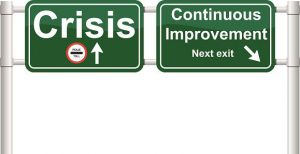Change is hard.
Humans tend to resist any sort of changes to routine or structure, because we appreciate predictability. We like consistency and form. We’re creatures of habit, and transformation is scary.
But guess what? Things don’t get better unless they change.
Changing with Kaizen Events
That’s where the concept of Kaizen comes from. It’s a Japanese term that, when loosely translated, means ‘change for the better.’ It’s about iterating. Getting stronger. Continuously improving. And Kaizen – not creativity, or teamwork, or brand clarity – was an organizational cornerstone for Toyota, the world’s third-largest automaker.
“Toyota started by copying the technology of the front-runners,” said Akio Toyoda, the third-generation president of Toyota. “The company has made improvements on the existing technology, which has led to innovation. What’s wrong about imitating and improving on others?”
Kaizen usually manifests in small gatherings called Kaizen Events – a collection of a few employees, who typically work together for about three to five days to overcome a very specific challenge. These events are usually non-structured and brainstorming-intensive, led and managed by a single person or entity.
Organizations that ingrain Kaizen and Kaizen Events into their culture can create a sense of empowerment among employees. It’s not unusual to see Kaizen Events with only one employee working to solve his or her most pertinent problem. This type of Kaizen-based thinking – focused on being better and continuously improving – often inspires problem solving and creative thought in people at all levels of an organization.
It might sound a little strange, but these events aren’t so different than Six Sigma’s DMAIC methodology. It’s about defining a problem, using data and insight to develop a solution, and then implementing and observing the solution. It’s a big reason why Kaizen and process improvement methodologies like Six Sigma work so well together (and why Jeff Bezos, founder and CEO of Amazon, is a big proponent of them).
So, if it aligns with Six Sigma, it must be manufacturer-focused, right? Not exactly. That’s a common misconception (about both Kaizen and Six Sigma), but in reality, these principles have helped improve all types of organizations – like the aforementioned Amazon, a Turkish gold mine (seriously, a literal gold mine), and many more.
One of the best examples comes from New York City.
Kaizen Kitchen
Back in 2013, the Community Kitchen & Food Pantry of West Harlem – a soup kitchen for Harlem’s under-served population – was experiencing a problem. They had to serve between 300 and 500 clients every evening, and they didn’t have the staff (or the space) to accommodate that demand. Clients would get stuck waiting in long lines, often in bad weather, and the problem was only getting worse.
Community Kitchen reached out for help and secured financial donations from many large businesses. Toyota was one of those large businesses that took notice of the soup kitchen’s situation, but instead of donating money, Toyota decided to bring donate their Kaizen Event philosophy.
The Toyota team paid a visit to Community Kitchen, and they immediately made a few changes.
- No more batching – Previously, Community Kitchen would serve clients in batches of 10. Ten people would eat their food, finish their meal, get up and leave, and then the next 10 clients would take their place. After some careful observation by the Toyota team, they realized that, instead of waiting for all 10 previous clients to finish, it would be quicker to fill the open seats individually – as soon as each client finished his or her meal.
- On-deck waiting area – Instead of escorting clients from the line to the seating area, Toyota suggested the use of an ‘on-deck’ area, where the clients who were next-up for service could be closer to food trays and supplies. That way, when it was time for them to eat, there was no hesitation about where to walk or what to do.
- A point-person – To help efficiently process clients in-and-out, Toyota suggested that one of the staff members patrol the floor. This person’s job was to locate empty seats and escort the next client to the table.
These simple improvements – implemented without spending any money – dropped the average client wait time from 90 minutes to 18 minutes. Toyota totally transformed the way the Community Kitchen & Food Pantry operated.
That’s the power of a Kaizen Event. Take what you have and improve it.
Make it better.
Change. For good.



